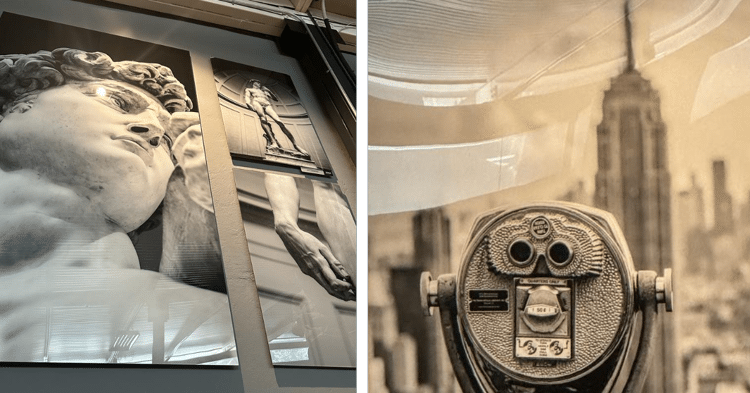From canvas to precision: the secret behind reproducing artwork

James Gatica explores the reproducing arts of work using digital printing and provide 3 key tips for printers who are interested in exploring this niche sector.
Reproductions of works of art have emerged as a crossover between artistic and technical prowess within the specialised printing industry. These remarkable prints accurately capture the essence of the original masterpieces, allowing art enthusiasts and collectors to experience the beauty and intricacies of renowned works of art with stunning precision and attention to detail. In this article, we explore the techniques and skills that should be considered when entering the business of printing art. We will also look at 3 key tips for printers who are interested in venturing into this business.
Reproductions of works of art go beyond using traditional printing methods and are a unique art form. Achieving accurate colour representation, resolution, and substrate selection are crucial components of this process. High-resolution scanning techniques capture every delicate brush stroke and texture, ensuring the print is true to the original masterpiece.
Advanced printers and pigment inks ensure the longevity of prints and stop them from fading or deteriorating. In addition, meticulous colour calibration and profiling significantly contribute in achieving impeccable colour accuracy and ensuring reproductions of art are indistinguishable from the originals.
Customer expectations

Whilst speaking to FESPA, Cardenas said that "customers are always interested in having the highest quality. Customer like to easily find what they are looking for online regardless of their location. That is what customers are demanding and what we try to achieve, as we try to innovate."
Factors To Consider
Master colour management and calibration
Reproductions of works of art rely heavily on accurate colour representation. Professionals should have in-depth knowledge of colour spaces, such as Adobe RGB and ProPhoto RGB, and be skilled at colour matching between various devices such as scanners, monitors, and printers. Calibration tools, such as colorimeters and spectrophotometers, are essential to maintain consistency and achieve accurate colour reproduction.
High-quality substrate selection
The choice of substrate has a significant impact on the quality and longevity of the final print. Professionals should be familiar with selecting acid-free, papers and canvases that are resistant to fading, yellowing, and influences the environment. Different works of art may require specific textures and finishes to retain the original essence, therefore experts must be mindful when choosing the correct substrate and ensure that they tailor it to the unique needs of each project.
Domains of post-production techniques
After scanning and printing, post-processing plays a vital role in refining artwork reproductions. Professionals should be experts in using editing software of images such as Adobe Photoshop to improve sharpness, adjust contrast and remove imperfections, while preserving the authenticity of the artwork. Attention to detail and a deep appreciation for art are fundamental in achieving exceptional results.
The Profutability of speciality printing
Reproductions of artwork offer a rewarding opportunity for professionals in the specialty printing industry. Doing so allows for the preservation of cultural heritage and makes art accessible to a wider audience, the demand for high-quality reproduction prints continues to grow. By honing their colour management skills, mastering substrate selection, and excelling at post-production techniques, professionals can excel in this niche market.

Reproductions of works of art exemplify the harmonious union between artistic and technical mastery within the specialized printing industry. Accurate colour representation, substrate selection and post-production techniques are vital to achieve exceptional results. Professionals who venture into the reproductions of fine art can take pride in preserving cultural heritage and contribute to the accessibility of art for enthusiasts and collectors alike. By embracing the art and technology behind these prints and applying the essential tips described, printers can embark on a rewarding and successful journey in this captivating world.
Topics
Interested in joining our community?
Enquire today about joining your local FESPA Association or FESPA Direct
Recent news
.png?width=550)
FESPA Middle East Day 2 Highlights
The 2nd day of FESPA Middle East, 21 January 2025, saw a hive of activity with hundreds of professionals visiting the show to see the latest solutions and innovations in speciality print and signage.
.png?width=550)
FESPA Middle East 2025 - Day 1 Highlights
The video shows you all the live action from day 1 of the expo including the kick-off of the World Wrap Masters competition, the free sessions in the conference, and the buzz of networking and doing business on the show floor.

Creative Collaboration with AI - How to develop Decorated Apparel design themes part 2
In this second article, Mark Coudray shares how to leverage AI programs to create interesting, commercial brand graphics for advertising, signage, apparel, and promotional products, with a key focus on decorated apparel.

How to perfect personalisation in printed packaging
Packaging is one market that has been cited as a growth area for some time now, but if you combine this up with another sector of opportunity in terms of personalisation, this can open even more doors for printers. Here, Rob Fletcher takes a closer look at packaging personalisation.